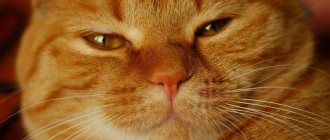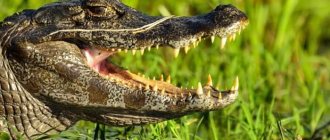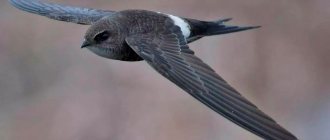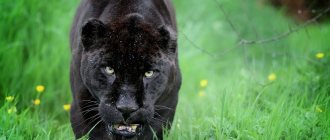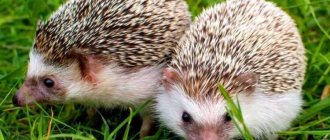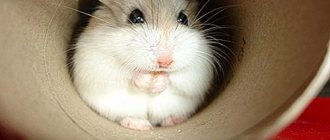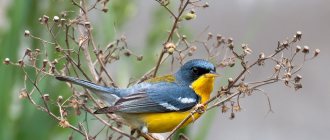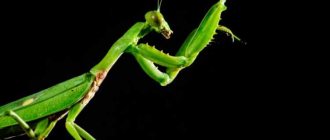The fastest animal in the world: Unsplash The speed of the fastest animals in the world reaches several hundred kilometers per hour. This is enough to overtake a car. The top 10 fastest animals include birds, fish and even bats.
Who are the fastest animals in the world? Peregrine falcon, golden eagle, needle-tailed swift, Brazilian folded lip, sailfish, cheetah, black marlin, Anna's calyptus, pronghorn and springbok are the best sprinters in the world.
Peregrine Falcon
What animal is the fastest in the world? The peregrine falcon is the fastest bird and the fastest animal in the world. Its diving speed exceeds 300 km/h, and the maximum possible speed reaches an incredible 390 km/h.
Why is the peregrine falcon the fastest animal in the world? The bird of prey of the falcon family is perfectly adapted to catching prey. Its length does not exceed 50 cm, and its wingspan is 120 cm. The peregrine falcon has a large build and a long tail. The bird literally falls like a stone, killing even large prey with one powerful blow with its claws at high speed.
Sapsan: Wikipedia
The peregrine falcon is under the protection of states and international organizations; trade in this bird is prohibited. The fastest bird in the world plays an important role in the cultural symbolism of different peoples:
- The Egyptian sky god Horus was depicted with the head of a peregrine falcon.
- The bird is depicted on the coats of arms of a number of cities and countries.
- A Japanese fighter plane and spacecraft are named after her.
- The speed of the Russian Railways electric train "Sapsan" is comparable to the speed of the animal after which it was named.
Elk
Elk is a stately and large animal weighing up to 600 kilograms, but it can run at a speed of 75 km/h. On the plain, this animal moves very quickly and defends itself from attackers with strong blows of its front legs, so it does not always become prey for predators. Moose live mainly in the Northern forests. A distinctive feature of these animals are their horns, reaching a span of up to 1.8 meters. Moose feed on vegetation, mushrooms, and tree branches in winter.
Golden eagle
Another representative of birds among the fastest animals in the world is the golden eagle. The bird is a formidable predator in the Northern Hemisphere. Prefers life in the mountains, although it can also live on the plains.
The golden eagle is a large representative of the hawk family. He is the largest among the eagles. The bird's body length reaches 93 cm, its wingspan is over 2 m. The weight of the golden eagle is more than 6 kg. The bird is armed not only with a beak and claws, but also with eagle vision: the golden eagle notices prey from a distance of 2 km.
Golden eagle: Wikipedia
The golden eagle's tactics for catching prey vary. In clear weather, a large eagle soars high above the ground, and, having spotted a prey, quickly dives towards it. The speed of such a fall reaches 320 km/h. In cloudy weather, the golden eagle can ambush on a tall tree.
With age, the bird's hunting qualities improve: if a young golden eagle catches only 1 out of 20 hares, then an experienced hunter practically makes no mistakes.
Meerkats: description
Meerkats are the smallest members of the mongoose family. They prefer to live in burrows in numerous groups, numbering up to 3 dozen individuals. These are quite “social” animals that use a set of sounds, including at least 10 sound combinations, to communicate with each other.
Meerkat - Interesting facts about the species | Mammal species meerkat
Appearance
Meerkats grow on average to 25-35 cm in length, with the tail length ranging from 16-24 cm. The weight of adult individuals barely reaches 1 kilogram, and on average their weight is about 750 grams. The body is elongated, allowing the animals to easily move in their burrows, as well as in thickets of various vegetation. The main color depends on the habitat, so the color of the coat varies from dark brown shades to light gray, fawn and bright red tones.
Meerkats, which live in warmer climates, are characterized by a darker coat color, while the inhabitants of the Kalahari are distinguished by a fawn or slightly reddish color. Representatives of the family, living in the dunes of Angola and Namibia, are characterized by a bright red color. The color of the coat is not uniform, so the hair on the head is lighter compared to the rest of the body. Around the eyes the coat color is darker, which makes the eyes stand out. The dorsal area is colored with longitudinal dark brown or black stripes.
Interesting to know! The belly area is not covered with coarse hair, but only with soft undercoat.
Thin-tailed myrkats do not have warm, high-quality fur, so in order not to freeze, they have to sleep closely huddled together. Since it is quite cold in the desert, they have to warm up in the morning hours in the sun. The tail is thin and long, cone-shaped, covered with dense, although short, hair. The tail is colored to match the color of the whole body, but the tip of the tail is darker, as are the stripes on the back.
The tail of meerkats is quite functional, as it helps the animals stand on their hind legs, helps in intimidating opponents, and also helps repel snake attacks. Meerkats have an elongated, pointed muzzle with a soft, dark brown nose. Animals have a very delicate sense of smell, which allows the animals to quickly find food for themselves, as well as detect the appearance of strangers on their territory many kilometers away. Using their sense of smell, they recognize their own, identify various diseases, the approach of childbirth, and also recognize strangers.
On the head there are also ears in the form of crescents, black in color, as are the circles around the eyes. The ears are set relatively low, which allows the animals to better hear the approach of various predators, in the form of jackals.
Interesting moment! When animals dig holes for themselves, their ears are closed so that earth cannot get into them.
Meerkats have relatively large and forward-facing eyes, which distinguishes them from rodents. The fur around the eyes, which is dark in color, protects the eyes from the bright sun and also visually increases their size. The circles around the eyes create the feeling of a scary and greedy animal, especially with large eyes, which scares off some predators.
The main food of meerkats is insects and small vertebrates, so they are armed with sharp molars and slightly curved incisors. The animals easily cope with the shells of scorpions, the chitinous cover of various beetles and centipedes, the bones of animals, as well as the eggs of some birds that nest on the ground.
Meerkats move by leaning on all 4 limbs and holding their tail high. At short distances they accelerate up to 30 km/h, which allows them to quickly hide in their burrows when predators approach. In a pose, standing on their hind legs, these animals look out for their natural enemies due to their keen vision directed into the distance.
Important point! They use their keen vision to protect themselves from various predators. When going in search of food, meerkats make greater use of their subtle sense of smell.
Each paw has 4 long claws of a non-retractable type, while the claws on the front paws are longer and curved. This is necessary for quickly digging holes, as well as for digging out various living creatures that are hiding in the ground (in the sand). You can distinguish a female from a male if you pay attention to the size of the individuals: females are larger compared to males.
Character and lifestyle
Thin-tailed myrkats prefer to live in colonies, with each group containing up to 30 individuals related by blood. Sometimes larger groups of up to 60 individuals are found. As a rule, individuals from other groups are not accepted, although such cases do occur. The group is led by an adult female. Next up the hierarchy are other females, and then adult males. Juveniles and cubs occupy the lowest level. Pregnant females occupy a special position in the group, which is associated with maintaining high fertility.
Each family member knows his responsibilities. Young males and females are busy setting up burrows under the supervision of more experienced family members. The older members of the family stand guard and also hunt prey. The changing of the guard occurs every 3-4 hours. The replaced guards go in search of food. Mirkats are considered to be quite caring parents not only in relation to their cubs, but also to the cubs of other females. The entire flock is involved in feeding the grown offspring. Young meerkats look after the cubs if the females go hunting. At night, everyone huddles together and warms each other with the warmth of their bodies.
These animals prefer to lead a diurnal lifestyle. With the first rays of the sun they appear on the surface of the earth to warm up, since the night was cold. After this, each animal begins to carry out its duties. Some of them stand up to protect their living space, and some go in search of food. When the heat peaks, meerkats hide in their burrows, while they either widen or deepen the burrows, and also restore some underground communications. If necessary, unnecessary passages are buried, etc. In other words, they are not sitting idle.
When the heat begins to subside, it is time for the animals to hunt. After sunset, meerkats go to their burrows for the night.
Meerkats have to constantly roam in search of food, which is accompanied by group fights over feeding territories. In such inter-clan clashes, every fifth individual dies. This is especially true for females, as they most fiercely defend their burrows.
Interesting fact! Conflicts practically do not arise if there is enough food for everyone. When the food supply begins to become scarce, then fights begin between two neighboring families.
Intrafamily squabbles between the dominant female and females who dared to become pregnant without “permission” are also possible. The dominant female carefully monitors this process and, if something happens, the dominant female can take the life of not only the offending female, but also her offspring. Therefore, control over reproduction is strict. The mechanism of overpopulation is designed in such a way that females who have given birth can kill their cubs themselves, or leave them in burrows when they need to go in search of other territories.
The cubs of a dominant female may be attacked by another female who has encroached on the position of the dominant female. She leaves her offspring alive, but kills all the other cubs. If this happens, then this is evidence that the dominant female can no longer retain power and her place is taken by a young, strong and fertile female.
BBC Scandalous meerkats
How long do meerkats live?
Living in the wild, meerkats live no more than 7 years, and their average life expectancy is no more than 4 and a half years. These animals have a sufficient number of natural enemies, so it is very important for them to have high fertility. When kept in captivity, they can live 2 times longer. Under natural conditions, the mortality rate for cubs reaches 80 percent, and the mortality rate for adults is about 30 percent. The fact is that the dominant female regularly practices infanticide, killing the puppies of other females.
Where do they live?
Their habitat is associated with the southern regions of the African continent, represented by the territories of countries such as Namibia, South Africa, Botswana, Angola, Lesotho. Large numbers are concentrated in the vast Kalahari and Namib deserts. They live in open areas and deserts, where there is practically no vegetation in the form of trees and shrubs. The conditions of flat areas, as well as the conditions of savannas, where hard soil predominates, are suitable for them. These are ideal conditions for digging underground labyrinths, as well as searching for food.
What do they eat?
In the habitat areas of thin-tailed myrkats, there are not enough other fauna representatives to diversify the diet of these animals. They feed on any living creature that lives within their habitat. These can be various beetles, ants and their larvae, centipedes. If scorpions and spiders come across, they will also be eaten. They have naturally developed resistance to the venom of scorpions, as well as various protective secretions of insects and centipedes. The diet includes small vertebrates in the form of lizards, snakes and small birds. They destroy the nests of those birds that hatch eggs on the ground or in the grass.
Despite the assumption, meerkats do not have immunity against snake venom, so after being bitten by a snake, the meerkat dies. In fact, such a phenomenon is rare, since meerkats come out victorious in a duel with snakes, as they have unique mobility and reaction. Meerkats often eat succulent parts of various vegetation, root systems and bulbs.
Reproduction and offspring
Slender-tailed myrkats can reproduce after reaching 1 year of age. Healthy adult females can give birth to offspring up to 4 times a year, and each time she gives birth to up to 7 cubs. The breeding season begins in September and ends in March.
After fertilization, the female carries her future offspring for 2 and a half months, after which blind and helpless cubs are born. Each newborn weighs no more than 30 grams.
After two weeks of life, puppies open their eyes, and they begin the period of learning to become adults. After 2 months of life, they begin to try adult food in the form of insects. At first, the mother, as well as other members of the family, are responsible for feeding the offspring, and then the young meerkats begin to obtain food for themselves on their own. Their older brothers and sisters are involved in raising the younger generation. They look after young individuals, arrange games, and also protect them from possible predators.
It is important to know! Only the dominant female has the right to become pregnant, although sometimes other females become pregnant, which entails intra-family conflicts.
Young animals learn in a fairly active way, so the grown-up offspring participate in hunting together with adults. First they eat dead prey, and then live, but rendered harmless. From such examples, young meerkats learn to get food for themselves, dealing with the prey on their own. If the prey is larger and the juveniles do not yet know how to cope with it, then the adults help, but only observe their skills. When adults are convinced that young individuals are able to cope with any prey, they release them to hunt unaccompanied by adults.
During the learning process, young individuals “get acquainted” with possible food items, in the form of snakes, lizards, spiders, centipedes, etc. Almost every adult meerkat knows how to deal with other potential prey. Grown-up meerkats may leave their family to form their own clan. In this case, they receive the status of strangers and will no longer be allowed to return. They are not even allowed onto their (former) territory.
Natural enemies
Meerkats have a huge number of people who want to profit from such animals. Large birds of prey in the form of eagles can cope even with adult individuals. Quite often, females desperately protect their offspring by sacrificing themselves.
Important fact! Since these animals are constantly at war with each other, they are actually natural enemies for themselves in the first place.
In the early morning, when meerkats appear on the surface of the earth to bask, and also in the evening, meerkats are attacked by jackals. A king cobra may appear in burrows and eat the emerging offspring, while it can also cope with adults that it takes by surprise.
The meerkat is an aggressive relative of the mongoose. Clan wars, division of labor, matriarchy.
Spine-tailed Swift
The needle-tailed swift, or keytail, is one of the fastest birds in the world. This representative of the swift family reaches a speed of 170 km/h in horizontal flight. In terms of speed of horizontal flight, the bird has no equal in the animal world, second only to diving predators.
Spine-tailed Swift: Wikipedia
The needle-tailed swift is a fairly large representative of the swift family. The bird reaches 22 cm in length, with a wingspan of up to 55 cm. The species received its name due to its special tail. Swifts live in Asia and winter in Australia. They stay in flocks and never land on the ground. They often settle in groves with hollow trees and near water bodies.
Grant's Gazelle
A graceful animal with long beautiful horns that can run fast and for a long time is Grant's gazelle. Speeds up to 85 km/h. This gazelle lives on the plains of Africa and avoids places with high vegetation. They easily survive in areas where there is no water. Some males prefer a “permanent residence”, and most of the representatives of this species move in herds. The weight of animals reaches 65 kilograms.
Brazilian folded lip
The Brazilian folded lip is one of the fastest flying animals in the world. A bat of this species can reach speeds of over 100 km/h, and some individuals move at a speed of 160 km/h. The body length of the bat is 9 cm, weight - 15 grams.
Brazilian folded lip: Wikipedia
Folded lips are not aggressive animals, so scientists are actively studying them. As a result of observations, a complex communication system of folded lips was discovered, in which 20 syllables are represented.
Bats form communities of up to several thousand individuals. Some colonies in Brazil number 20 million folded lips and are considered the world's largest concentrations of mammals.
The folded lips are important for agriculture because they destroy the cotton bollworm. In addition, one colony can eat up to a ton of mosquitoes.
Leopard
The first in our ranking of fast animals is the leopard. This graceful and beautiful animal can run at a speed of 58 km/h. Leopards live mainly in Asia and Africa. The lifespan of these felines is 10-15 years, but often their life is much shorter, since they are shot by poachers because of their beautiful fur. In the last century, the leopard was listed in the Red Book. A distinctive feature of these graceful big cats is their hunting style. When pursuing prey, they are in no hurry to expend their energy, but slowly and carefully lure the victim into an ambush. The largest leopard weighs 75 kilograms. In nature, in addition to spotted individuals, there are black representatives and they are called panthers.
Sailfish
The sailfish is the fastest-swimming fish in the world. It reaches a speed of 100 km/h underwater. The highest recorded speed of the sailing ship was 109 km/h. In three seconds, the record holder swims about 90 m.
The main external distinguishing feature of the fish is its long and high dorsal fin, similar to a sail. In addition, the fish has a pointed snout and resembles a swordfish.
Sailfish: Wikipedia
The sailfish is an excellent predator. Thanks to a special method of movement, the fish reduces water resistance and uses its turbulence. She actively moves her caudal fin in a small amplitude. The record holder does not have a swim bladder, he would only get in the way at such speeds. Therefore, the fish has negative buoyancy (by all parameters it should sink), but the shape of the body and muscle efforts compensate for this property.
Cheetah
The cheetah is the fastest land animal in the world. Its speed reaches 110 km/h.
Among cheetahs, records are recorded for the 100-meter race. The current world record for cheetahs is held by a female named Sarah from the Cincinnati Zoo. She managed to cover the distance in 5.95 seconds. For comparison: the current 100m world record, set by Jamaican W. Bolt, is 9.58 seconds.
Cheetah: Wikipedia
Cheetahs differ in structure from other cats. They have a slender body with very developed muscles, they have practically no fat deposits. The small head and rounded ears provide streamlining and excellent aerodynamic properties of the body. To provide the body with enough oxygen during an ultra-high-speed race, cheetahs received lungs with a large volume.
Keeping at home
Meerkats are highly tamed. In their natural habitat, they are often kept as exterminators of rodents, spiders, insects and snakes. The animals, accustomed to warmth, are very sensitive to low temperatures, but if proper conditions are provided, they can be kept in places with cold climates, including Russia.
Meerkats kept as pets are not inferior to cats and dogs that are more familiar to us in their sociability, playfulness and cheerfulness. In addition, the animals do not damage furniture, do not chew wires, do not make a lot of noise and are friendly towards all inhabitants of the house.
However, keeping such an exotic pet has some features:
- since in natural conditions animals live in families, it is better to purchase two animals so that they can communicate with each other and take care of each other;
- meerkats should not be kept in cages, but in a free settlement; for rest they will need a house with bedding;
- animals learn to go to the litter box, but training will take some time;
- In summer, animals can be walked on a leash; with the onset of cold weather, walks should be canceled;
- Meerkats do not like to bathe or swim, so water procedures should not be carried out too often.
Owners will also have to take care of timely vaccination of their pets against distemper and rabies. Meerkats are vaccinated in the same way as ferrets.
Before purchasing an animal from a nursery, you should inquire about the living conditions of the animals. As a rule, home-bred cubs are already litter box trained and are more tame and affectionate. If animals are kept in enclosures, caring for them at first will be associated with certain difficulties.
Black Marlin
Black marlin is one of the fastest fish in the world. Its swimming speed reaches 100 km/h. Marlins are giants: their weight reaches 750 kg. The species is classified as a commercial fish, although the annual catch is small - it does not exceed 6–7 thousand tons.
Black marlin: Wikipedia
Marlin is a serious predator. It feeds on pelagic fish, crustaceans and squid. The favorite fish of marlins is anchovies. In addition to their commercial value, marlins are a valuable object for sport fishing. Catching a giant is the cherished dream of fishermen.
Currently, marlin caught during the competition are released into the wild. Marlin meat is considered a delicacy and is very expensive in top restaurants.
Kalypta Anna
Calyptus Anna is one of the fastest birds in the world. In horizontal flight its speed reaches 100 km/h. The bird has a body length of about 10 cm and a wingspan of 11–12 cm. Females and males are different. Males have green plumage with a metallic tint, while females have gray plumage with small red markings.
Kalypta Anna: Wikipedia
The uniqueness of this species of the hummingbird family is its tiny size. Thanks to this, Anna's calypta is the world record holder for the speed of movement relative to the size of its body. In a second, a hummingbird moves 385 times its body size. With this movement, the bird experiences a load of 10 g. To move comparable to the kalipta, a person would need to reach a speed of 2000 km/h.
Lifestyle and character traits
Meerkats are diurnal animals and emerge from their burrows at sunrise. These are social animals that live in families, which, in turn, also form groups.
The colonial system is not typical for predatory species, so meerkats are considered an original exception.
Lifestyle of meerkats
Family groups consist of 20 to 35 individuals, the maximum recorded number is 63 animals. It is difficult for small groups to feed and look out for predators at the same time, and for too large groups it is difficult to find food in one place.
Colonies often fight among themselves over territories, food plots, and females. Despite their size, meerkats are quite bloodthirsty animals and in fights they become ferocious and merciless. Brawls often end in serious injury and death of animals. According to statistics, about 5% of meerkats die during fights with relatives.
Family groups can occupy territories from 1 to 3 square kilometers. There may be from 3 to 5 additional burrows and one main one on the site.
Meerkats are actively burrowing animals. Most individuals spend most of the day digging new burrows or searching for food under stones or plant roots. But meerkats are not at all opposed to taking over the empty living space of a ground squirrel or other animals.
The depth of the hole is from one and a half meters, some tunnels can stretch three meters or more.
Recommended by topic
Fox Panda Lynx
The hole has several entrances and exits, which help the nimble animals avoid meeting a predator and calmly escape to another shelter. Representatives of the species that live in mountainous areas and areas with rocky soil prefer to settle in small crevices and caves. Each family has spare holes in case they have to urgently change their place of settlement or run away from predatory animals. Typically, the entrances and exits from such burrows are located under the roots of plants or hidden behind stones.
Meerkats often change their place of residence in search of food. This tactic helps not only to find more food, but also to confuse predators who have discovered the settlement. Animals dig new holes at a distance of 1–3 km from the old place. Sometimes the relocation of animals can occur due to the fact that parasites have appeared in the old hole. Animals may leave their old place if rival groups that outnumber them approach their burrows.
Meerkats mark their territory with excrement and gland secretions. By smell, alien animals can determine the age, gender and even status of the meerkat in the group.
During daylight hours, meerkats often bask in the sun. At the same time, the animals can take the most unusual poses or lie in an embrace with their relatives.
Each family is formed from an adult male, a female and their offspring. Typically, females are larger than males and occupy a dominant position in the group.
Meerkats often communicate with each other using about 20–25 different sounds and their combinations. Animals easily recognize relatives by voice and can find their permanent partner or babies in a matter of seconds, even if all the animals are standing in a dense group.
Character and habits
Early in the morning, the animals come out of their holes, clear the entrances and exits and begin searching for food. Day after day, meerkats repeat the same actions, which resemble a ritual. At lunchtime, in the heat, predators hide in the shade and rest, and then go back in search of food.
Meerkats return to their burrows two hours before sunset.
At night, meerkats sleep in close groups, which helps the animals retain warmth. Moreover, babies most often end up under the bodies of adult animals right in. During the night, individuals move from outside to inside the ball to warm themselves, and new meerkats take their place.
While the whole family is searching for food, several individuals are observing the territory. The watchmen keep a vigilant eye on the horizon and do not forget to look up. Meerkats try to climb higher on rocks, hills and fallen trees. At the first sign of danger, the guard meerkats make shrill sounds that the entire group hears. At the signal, the animals rush to cover and hide.
A very important place among meerkats is given to caring for each other. Animals constantly comb out the fur of their relatives, choosing garbage and insects. In this way they strongly resemble monkeys.
Meerkats hibernate briefly during the rainy season or when there is no food. After hibernation, you can see entire groups of animals basking in the sun. They can stand motionless for an hour, squinting their eyes and lowering their paws.
Despite the fact that meerkats engage in fierce fights for territories, inside the colony they behave very friendly. Scientists explain this by saying that animals understand the degree of dependence on each other and try not to violate discipline. But female leaders are forced to defend the right to their place, so serious fights can occur between them, even within the family.
Pronghorn
The pronghorn, or pronghorn antelope, is the fastest land animal that is not a predator. This is a ruminant, the only species of the pronghorn family.
The main distinguishing feature, which gave the animal its name, is its special hooked horns. Both males and females grow horns, although in the latter they are very small. The body length of the pronghorn is about 100–130 cm, height - up to 100 cm, weight reaches 60 kg.
Pronghorn: Wikipedia
Pronghorns can reach speeds of 90 km/h. This is facilitated by their special body structure. They have large lungs with a thick trachea. In addition, they have a huge heart: a ram's heart is half that of a pronghorn.
Raising young animals
“Nannies”, i.e., are responsible for raising the cubs in the meerkat family. all babies are under the supervision of two or three adults, while the rest of the family hunts. After the young animals grow up a little, they are handed over to “teachers” - meerkats, who will teach them hunting and other necessary skills.
It is interesting that only the dominant female produces offspring in a clan; exceptions can be made if the family is small and there is a clear shortage of young animals. In all other cases, a female who dares to bring a cub may be expelled from the clan or her babies may be killed. Moreover, females conflict precisely at the “moment of killing”; severe fights can occur between them. But as soon as the alpha female gives birth, she can safely leave her cubs with the one whose offspring she recently killed, or calmly nurse the children of her “rival.” This is observed only in meerkat clans.
Springbok
The springbok, or jumping antelope, is the pronghorn's rival for second place in the race for fastest ruminant. It can reach a speed of 90 km/h. Externally, the antelope looks like a gazelle.
Springbok: Wikipedia
Springboks prefer African semi-deserts with low grass and shrubs. The basis of the antelope's diet is grass, shoots and leaves. A springbok can live without water for several months.
Springboks not only run fast, but also jump high. In case of danger, the animal jumps vertically up to 3 m from its stand. Thus, the antelope warns its relatives about the approach of a predator.
The fastest animals in the world amaze with their speed. They will easily overtake not only any athlete, but also a car or train. Their study is the sphere of interest not only of biologists and geneticists, but also of engineers who can spy on the secrets of the mechanics of high-speed movement from fast animals.
Original article: https://www.nur.kz/leisure/interesting-facts/1682635-samoe-bystroe-zhivotnoe-v-mire/
Reproduction
Massage
Meerkats become ready to mate at the age of 12-14 months. Pregnancy lasts about 70 days, after which the babies are born with their eyes and ear canals closed. Babies begin to hear and see at 10-14 days of life. The female continues to feed her offspring with milk for up to two months. Then the grown-up meerkats are accustomed to solid food. First, they are brought caught live insects, and then they begin to take them out to independently search for food.
The social behavior of the clan is very well expressed in raising offspring: all adult members of the group are involved in training and protecting the cubs. During an attack by predators, they protect the young, often saving them at the cost of their lives.
Only the dominant female of the group has the right to bear offspring. If other cubs appear in the clan, she kills the newborn puppies, and their mother expels them from the family.
During the year, a female can give birth 3-4 times, and she gives birth to 5-7 cubs. The high fertility of meerkats ensures the stability of the population even despite the relatively short life cycle and high percentage of death from natural enemies. In the International Red Book the species has the status of “Least Concern”.
During observations of animals living in nature and in captivity, it was possible to establish that only predators living in natural conditions are caring parents. This feature of behavior is due to the fact that care for offspring is not inherent in these animals at the level of instincts, but is transmitted through the training of young animals in the pack.
